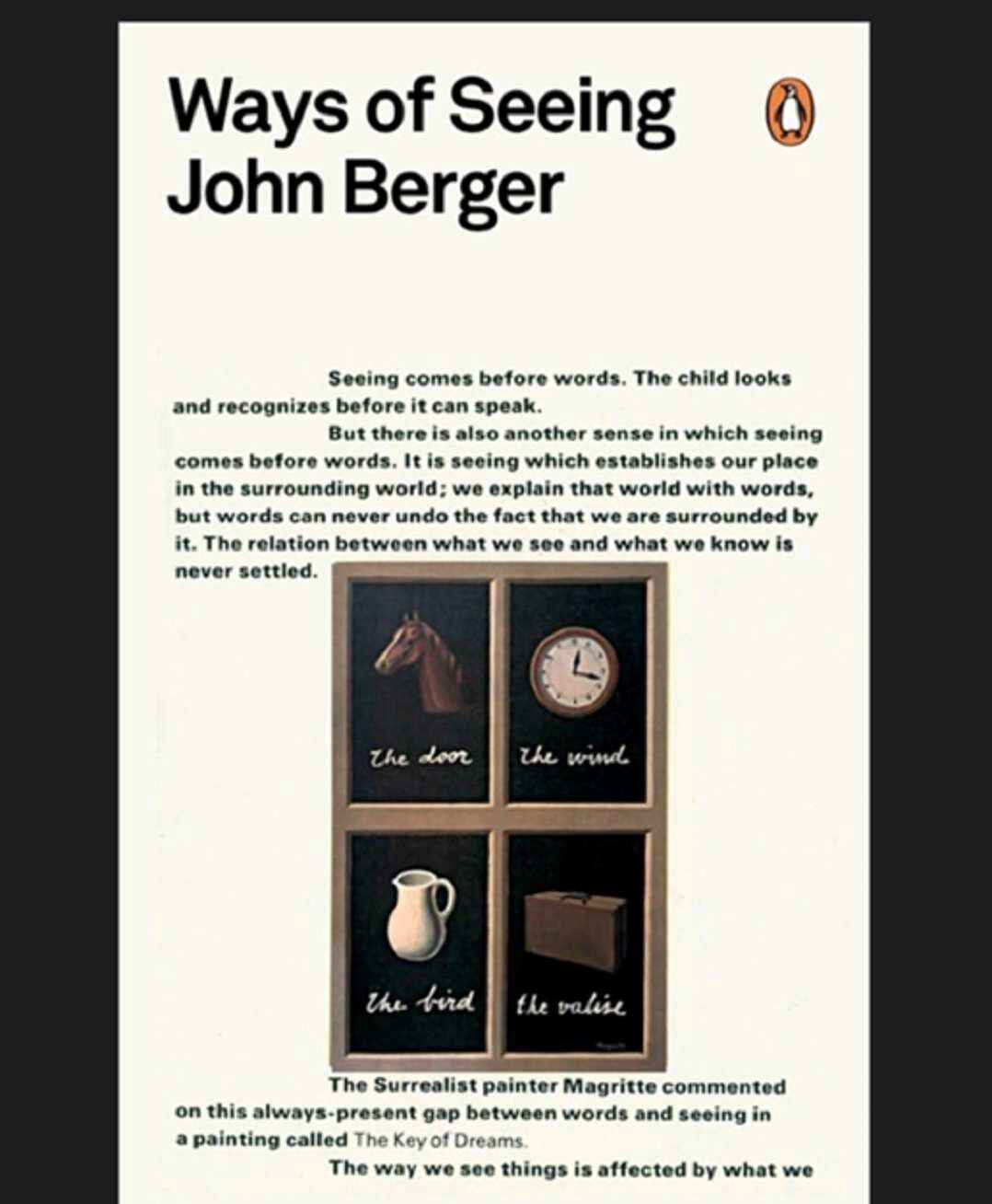"Ways of Seeing" by John Berger is like a guide to understanding art in a new way. Instead of sticking to the usual art rules, Berger takes us on a journey that questions how we see and think about art. It was a TV series in 1972. The book dives into art history, philosophy, and society. It shakes up how we look at art and encourages us to think more about what we see.
Some of the mind-blowing ideas Berger explores:
- Seeing Things:
Berger's main idea is that there is no one right way to see art. He challenges the idea that there is only one way to look at things. He shows how our experiences and the world shape the way we see art. So, it is not about what is in the painting; it is also about what is going on in our heads and in the world.
- The Power of Copies:
One cool thing Berger talks about is how copies of art change the way we understand it. Berger says that in a world where people can copy and share pictures a million times, the original artwork loses some of its specialness. It becomes disconnected from its history and the culture it came from. It is like the more copies there are, the less magical the original painting becomes.
- Looking at Women in Art:
Berger also talks about how women are often shown in art as objects of desire. He points out that men made a lot of famous paintings and often viewed women in a certain way. He wants us to question why women are so often shown as something to look at. It is a fresh perspective that makes us think about how art can reinforce stereotypes.
- Words and Pictures Together:
One cool thing about "Ways of Seeing" is how Berger mixes words and pictures. It is not just a bunch of boring essays; there are pictures too. Berger shows us that words and images go hand in hand. They work together to help us understand what is going on. It is like he is giving us a double dose of understanding and it makes the book way more interesting.
Think of "Ways of Seeing" as a time-traveling guide that keeps art appreciation fresh and exciting. It is perfect for both art lovers and beginners. Berger acts as your friendly companion, revealing hidden paths to understanding art.
In a world saturated with images, Berger's ideas are more relevant than ever. If you are curious about art and want to see it through a new lens, "Ways of Seeing" is a must-read.
The Wrap-Up:
"Ways of Seeing" is like a time-traveling guide to art that never gets old. John Berger makes us think about art in a way that is not stuck in the past. His book is perfect for people who love art and for those who are starting to explore it. It is like having a friendly guide who shows you all the secret paths to understanding art, and that is pretty awesome in our book. As we keep going in a world that is increasingly about pictures, Berger's ideas help us make sense of it all. So, if you are curious about art and want to see it in a whole new light, "Ways of Seeing" is the book to check out.
FAQs
- How does John Berger challenge the concept of the "male gaze" in art?
A: Berger argues that women in art are often depicted through the "male gaze," meaning they are seen as objects of desire for men rather than as individuals. He points out how women are frequently positioned passively, with their bodies on display. By analyzing these portrayals, Berger encourages us to question the power dynamics at play and consider how gender roles are reinforced through art.
- Why is "Ways of Seeing" considered a significant work in art criticism?
"Ways of Seeing" is considered significant in art criticism because it goes beyond traditional norms. John Berger introduces fresh ideas about how we see art. He challenges the concept of a single, objective view. He explores the influence of reproduction. He also looks at the objectification of women in art. And he looks at the close relationship between words and images. This makes the book thought-provoking and influential in the field.
- How does John Berger address the role of reproduction in art in "Ways of Seeing"?
John Berger delves into the role of reproduction in shaping our understanding of art. He argues that copying images reduces the original artwork's aura. It also separates it from its history and culture. Berger prompts readers to consider how copies change how we see and value art. This happens in a modern, image-filled world.
- What is the significance of the female gaze in "Ways of Seeing"?
In "Ways of Seeing," John Berger introduces a feminist perspective by examining the historical portrayal of women in art. He critiques the male gaze. In old art, he points out how artists have often objectified women and portrayed them as objects of desire. Berger's exploration prompts readers to reconsider the norms. It asks them to think about power in art.
- How does John Berger approach the combination of words and images in "Ways of Seeing"?
John Berger combines words and images in "Ways of Seeing" to enhance the reader's understanding. The book has a dynamic mix of essays and visuals. Language and visuals prove their interconnectedness. This unique approach makes complex ideas easier to understand. It also shows that words and images shape our views of art.
References
- Schirato, T., & Webb, J. (2016). Inside/outside: Ways of seeing the world. In Culture, heritage and representation (pp. 37-56). Routledge.
- Jacob, P., & Jeannerod, M. (2003). Ways of seeing: The scope and limits of visual cognition.
- Berger, J. (2008). Ways of seeing. Penguin UK.









